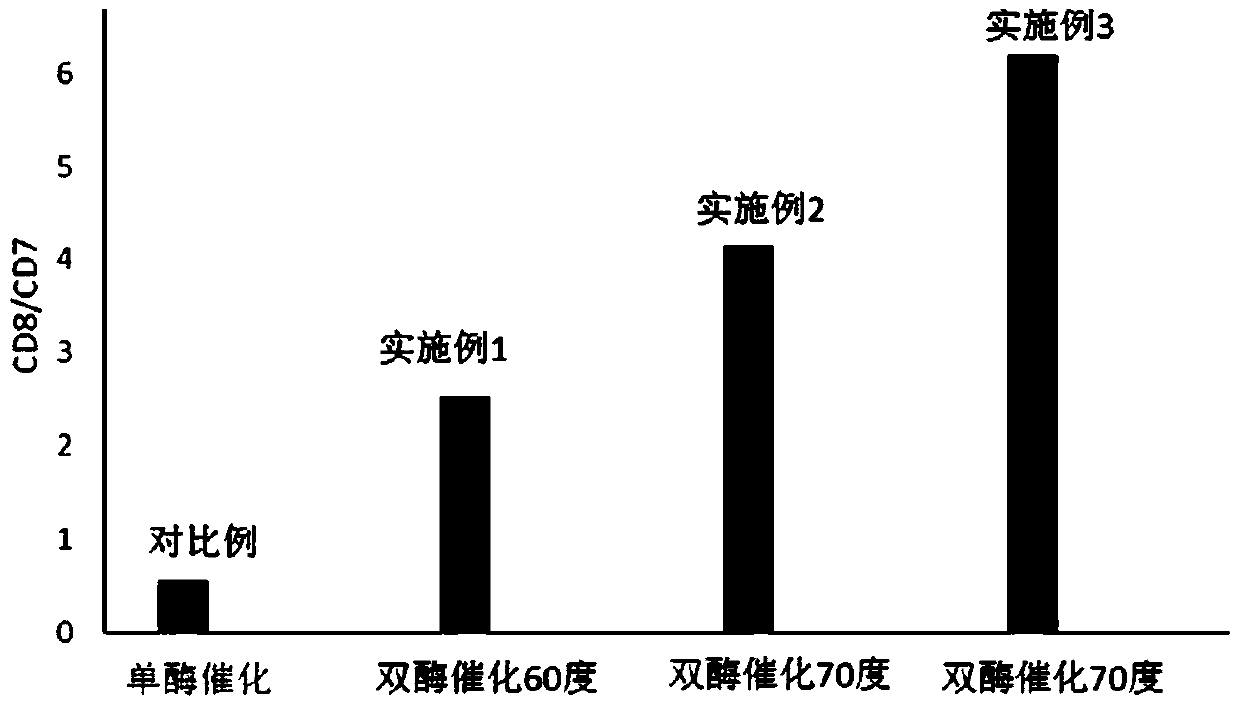A method for improving the specificity of γ-cyclodextrin with two enzymes
A cyclodextrin, specific technology, applied in fermentation and other directions, can solve the problem of low specificity of γ-cyclodextrin, and achieve the effect of improving specificity and increasing catalytic temperature
- Summary
- Abstract
- Description
- Claims
- Application Information
AI Technical Summary
Problems solved by technology
Method used
Image
Examples
Embodiment 1
[0023] (1) Dissolve cornstarch in 50ml of Tris-Hcl buffer solution with a pH of 8.5 and a concentration of 50mmol / l to make a 1% solution, and heat it with microwave for 2-3min to gelatinize it.
[0024] (2) Take 1ml of the solution prepared in (1), first add 0.1U / g starch 4αGTase to react at 70°C for 24h to pretreat corn starch, and then add 0.5U / g starch CGTase to the reaction system at 60 Reaction at ℃ for 24h.
[0025] (3) Boil the reaction solution in step (2) to inactivate it for 30 minutes.
[0026] (4) Mix 500 ul of the reaction solution in step (3) with 500 ul of 0.2 M sodium acetate buffer solution at pH 4.2, and add 0.4 U / g starch glucoamylase to it and react at 38° C. for 16 h.
[0027] (5) Boil the reaction solution obtained in step (4) for 10 minutes to inactivate the enzyme, and centrifuge at 18000 g for 5 minutes after inactivating the enzyme.
[0028] (6) The cyclodextrin solution measured in the above steps was measured, and the ratio of γ-cyclodextrin / β-cy...
Embodiment 2
[0030] (1) Dissolve cornstarch in 50ml of Tris-Hcl buffer solution with a pH of 8.5 and a concentration of 50mmol / l to make a 1% solution, and heat it with microwave for 2-3min to gelatinize it.
[0031] (2) Take 1ml of the solution prepared in (1), first add 0.1U / g starch 4αGTase to react at 70°C for 24h to pretreat corn starch, and then add 0.5U / g starch CGTase to the reaction system at 70°C Under reaction 24h.
[0032] (3) Boil the reaction solution in step (2) to inactivate it for 30 minutes.
[0033] (4) Mix 500 ul of the reaction solution in step (3) with 500 ul of 0.2 M sodium acetate buffer solution at pH 4.2, and add 0.4 U / g starch glucoamylase to it and react at 38° C. for 16 h.
[0034] (5) Boil the reaction solution obtained in step (4) for 10 minutes to inactivate the enzyme, and centrifuge at 18000 g for 5 minutes after inactivating the enzyme.
[0035] (6) The cyclodextrin solution measured in the above steps was measured, and the ratio of γ-cyclodextrin / β-cyc...
Embodiment 3
[0037] (1) Dissolve cornstarch in 50ml of Tris-Hcl buffer solution with a pH of 8.5 and a concentration of 50mmol / l to make a 1% solution, and heat it with microwave for 2-3min to gelatinize it.
[0038] (2) Take 1ml of the solution prepared in (1), first add 0.05U / g starch 4αGTase to react at 70°C for 24h to pretreat corn starch, and then add 0.5U / g starch CGTase to the reaction system at 70 Reaction at ℃ for 24h.
[0039] (3) Boil the reaction solution in step (2) to inactivate it for 30 minutes.
[0040] (4) Mix 500 ul of the reaction solution in step (3) with 500 ul of 0.2 M sodium acetate buffer solution at pH 4.2, and add 0.4 U / g starch glucoamylase to it and react at 38° C. for 16 h.
[0041] (5) Boil the reaction solution obtained in step (4) for 10 minutes to inactivate the enzyme, and centrifuge at 18000 g for 5 minutes after inactivating the enzyme.
[0042] (6) The cyclodextrin solution measured in the above steps was measured, and the ratio of γ-cyclodextrin / β-c...
PUM
 Login to View More
Login to View More Abstract
Description
Claims
Application Information
 Login to View More
Login to View More - R&D
- Intellectual Property
- Life Sciences
- Materials
- Tech Scout
- Unparalleled Data Quality
- Higher Quality Content
- 60% Fewer Hallucinations
Browse by: Latest US Patents, China's latest patents, Technical Efficacy Thesaurus, Application Domain, Technology Topic, Popular Technical Reports.
© 2025 PatSnap. All rights reserved.Legal|Privacy policy|Modern Slavery Act Transparency Statement|Sitemap|About US| Contact US: help@patsnap.com

